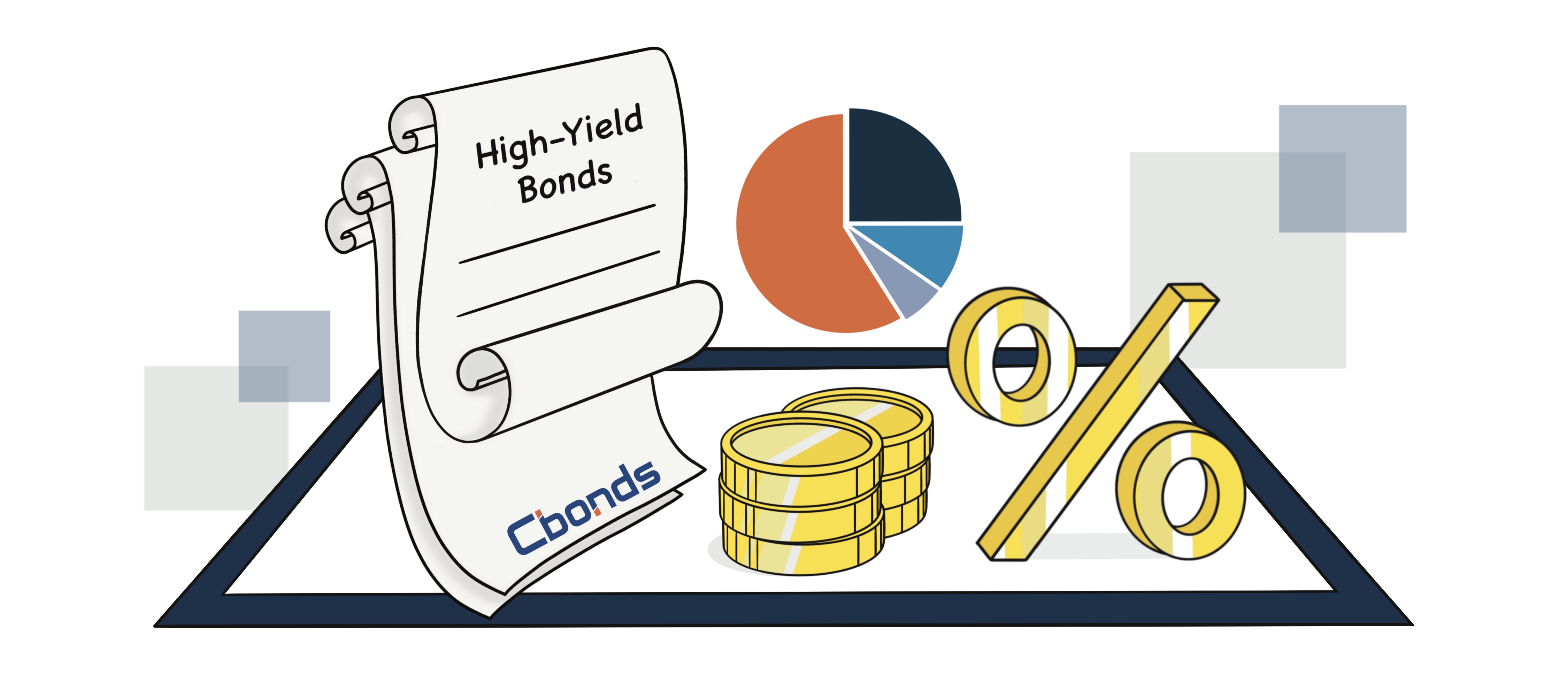By
Konstantin Vasilev Member of the Board of Directors of Cbonds, Ph.D. in Economics
Updated February 14, 2024
What Are High-Yield Bonds?
High-yield bonds, commonly referred to as "junk bonds," represent a category of corporate debt securities that offer higher interest rates than their investment-grade counterparts. These bonds are issued by companies with lower credit ratings, typically below BBB- from Standard & Poor’s and Fitch, or below Baa3 from Moody’s. The elevated interest rates on high-yield bonds serve as compensation for the increased risk of default associated with these issuers. Such bonds are frequently issued by startup companies, capital-intensive firms with high debt ratios, or those that have lost their investment-grade status, termed "fallen angels."
In the field of fixed-income securities, returns on high-yield bonds tend to be less volatile because the income component of the return is typically larger, providing an added measure of stability. However, the heightened potential for default makes them riskier investments compared to investment-grade bonds. Investors attracted to the allure of higher yields must carefully assess and manage the credit risk associated with these instruments.

How Do High-Yield Bonds Work?
High-yield bonds function as debt instruments issued by corporations with the commitment to pay interest and return the principal amount at maturity. Unlike investment-grade bonds, high-yield bonds come from companies with lower credit quality, often carrying credit ratings below BBB- from Standard & Poor’s and Fitch, or below Baa3 from Moody’s. The allure of high-yield bonds lies in the potential for offering higher returns to investors, given the elevated risk associated with these issuers.
Investors in high-yield bonds essentially lend money to companies in return for periodic interest payments and the eventual return of the principal amount. The higher interest rates on these bonds act as compensation for the increased risk of default. It’s important for investors to recognize that high-yield bonds are not without their challenges, as they come with a higher likelihood of default, greater price volatility, and increased sensitivity to market interest rate fluctuations. Therefore, investors must carefully weigh the potential for higher returns against the inherent risks when incorporating high-yield bonds into their investment portfolios.
Benefits and Risks of High-Yield Bonds
Benefits
-
Enhanced Returns. High-yield bonds typically offer higher yields compared to investment-grade bonds, attracting investors seeking enhanced income potential.
-
Diversification. Investing in high-yield bonds can provide portfolio diversification as they often have a low correlation with other fixed-income sectors, such as Treasuries and highly rated corporate debt.
-
Capital Appreciation. Positive events like ratings upgrades, improved earnings reports, or favorable market-related developments can lead to capital appreciation, contributing to overall returns.
-
Equity-Like Returns. High-yield bonds and equities tend to respond similarly to market conditions, offering potential equity-like returns with less volatility.
-
Relatively Low Duration. Due to shorter maturities, high-yield bonds often have relatively low duration, making them less sensitive to day-to-day fluctuations in interest rates.
Risks
-
Default Risk. High-yield bonds are issued by companies with higher default risk, making default a significant concern for high-yield bond investors.
-
Higher Volatility. Historically, high-yield bond prices have demonstrated more volatility than their investment-grade counterparts, resembling the stock market’s volatility.
-
Interest Rate Risk. All bonds face interest rate risk, and high-yield bonds are no exception. Rising interest rates can lead to a decrease in bond prices.
-
Liquidity Risk. High-yield bonds generally carry higher liquidity risk compared to investment-grade bonds, making them potentially challenging to sell at desired prices.
-
Market Sensitivity. The high-yield sector’s performance is sensitive to economic conditions, and adverse market conditions may negatively impact high-yield companies more than investment-grade ones.
Legal Regulation of High-Yield Bonds
The legal regulations governing high-yield bonds primarily fall under securities laws and regulations that aim to protect investors and ensure transparency in the financial markets. Issuers of high-yield bonds must comply with the requirements set forth by regulatory bodies, such as the Securities and Exchange Commission (SEC) in the United States. The registration and disclosure process mandated by the SEC involves providing detailed information about the issuing company’s financial health, operations, and the intended use of proceeds from the bond issuance. This ensures that investors have access to essential information to make informed decisions regarding their investments in high-yield bonds.
Additionally, high-yield bond offerings may be subject to specific rules and guidelines set by relevant stock exchanges where these bonds are listed for trading. These regulations aim to maintain the integrity of the market and safeguard the interests of investors. Compliance with these legal frameworks helps establish a level playing field for market participants, fostering trust and confidence in the high-yield bond market. Investors, in turn, benefit from a structured and regulated environment that promotes fair practices and disclosure standards in the issuance and trading of high-yield bonds.
Investment Grade vs. Non-Investment Grade Corporate Bonds
Investment-grade and non-investment-grade bonds represent distinct categories within the fixed-income market, each characterized by varying levels of credit quality and risk. Investment-grade bonds are considered safer investments, typically carrying credit ratings of Baa3 or higher from Moody’s, or BBB- or higher from Standard & Poor’s and Fitch. These bonds are issued by financially stable entities, such as governments or well-established corporations, offering lower yields but a higher likelihood of meeting their financial obligations.
On the other hand, non-investment-grade bonds, often referred to as high-yield or junk bonds, have credit ratings below the investment-grade threshold. Issuers of these bonds are perceived as having a higher risk of default. Despite this increased risk, non-investment-grade corporate bond options attract investors seeking higher yields. These bonds are often issued by companies with lower credit quality, startups, or those facing financial challenges. Investors must carefully assess their risk tolerance and investment objectives when deciding between these two categories, as the potential for higher returns in non-investment-grade bonds comes with an elevated level of risk.
How to Invest in High-Yield Bonds
-
Understand High-Yield Bonds. Familiarize yourself with the characteristics of high-yield bonds, including their higher interest rates, lower credit ratings, and associated risks of default.
-
Assess Your Risk Tolerance. Evaluate your risk tolerance and investment goals. High-yield bonds can offer attractive yields but come with increased risk, so it’s crucial to align your investment strategy with your risk profile.
-
Conduct Research. Research individual high-yield bonds or high-yield bond funds. Examine credit ratings, issuer details, and historical performance. Utilize reputable financial news sources and bond rating agencies for comprehensive information.
-
Diversify Your Portfolio. Diversification is key to managing risk. Consider building a diversified portfolio by including bonds from different issuers, industries, and regions.
-
Direct Purchase or Fund Investment. Decide whether to buy high-yield bonds directly from broker-dealers or invest through mutual funds or exchange-traded funds (ETFs). Bond funds provide diversification and professional management.
-
Read Prospectuses. If investing in individual bonds, carefully read the bond’s prospectus. This document provides essential information about the issuing company’s financial health, plans for bond proceeds, and associated risks.
-
Monitor Interest Rates. Stay informed about market interest rates. High-yield bonds can be sensitive to interest rate changes, impacting their market value. Consider the potential effects on your investment in different economic scenarios.
-
Consideration of Economic Conditions. Evaluate the economic environment. High-yield bonds may perform differently during economic expansions or contractions, affecting default risk and overall market conditions.
-
Consult with Financial Advisors. Seek advice from financial advisors who specialize in fixed-income investments. They can provide personalized guidance based on your financial situation and investment objectives.
Bond Screener
Watchlist
Excel Add-in
API












